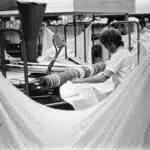Silk scarves are a luxurious accessory that can elevate any outfit, but they require special care to maintain their beauty and longevity. Silk is a delicate fabric that requires gentle handling and specific washing techniques to avoid damage. As a textile care expert, I have seen many silk scarves ruined due to improper cleaning methods. In this article, I will provide you with the knowledge and tools necessary for washing and caring for your silk scarves so that they remain beautiful for years to come.
To properly care for silk scarves, it is essential to understand their unique properties. Silk is a natural protein fiber that is known for its softness, luster, and drape. It is also highly absorbent, which means it can easily be stained by liquids or oils. When washing silk scarves, it is important to use gentle detergents and avoid harsh chemicals that can weaken the fibers or cause discoloration. Additionally, proper drying techniques are crucial in preventing shrinkage or stretching of the fabric. By following these guidelines and investing in quality care products, you can ensure your silk scarves remain a cherished addition to your wardrobe.
Understanding Silk Fabric
Silk is a luxurious and delicate fabric that has been prized for centuries. It is produced by the silkworm, which spins its cocoon using threads of silk. The resulting fabric is soft, smooth, and lustrous, with a unique sheen that sets it apart from other fabrics.
One of the key properties of silk fabric is its strength. Despite its delicate appearance, silk is actually one of the strongest natural fibers in the world. This makes it highly durable and resistant to wear and tear. Additionally, silk has excellent drape and flow characteristics, which make it ideal for use in clothing such as dresses, blouses, and scarves.
Compared to other fabrics such as cotton or polyester, silk has several distinct advantages. For one thing, it is much more breathable than synthetic fabrics like polyester, making it an excellent choice for warm weather clothing. Silk also has moisture-wicking properties that help keep you cool and dry even on hot days. Finally, because of its luxurious feel and beautiful drape, silk is often associated with high-end fashion and formal occasions.
With its unique properties and characteristics, it’s no wonder that silk is so highly valued in the world of fashion. However, as with any fine material, proper care is essential to ensure that your silk garments remain in top condition over time. In the following section we will discuss some tips for washing and caring for your delicate silk scarves so that they can be enjoyed for years to come.
Importance Of Proper Care
As we have learned in the previous section, silk is a luxurious fabric that is highly sought after for its many benefits. Silk scarves, in particular, are popular fashion accessories that can elevate any outfit and add a touch of elegance to one’s look. Not only do silk scarves feel soft and comfortable against the skin, but they also offer various benefits such as breathability, durability, and moisture-wicking properties.
With silk scarf fashion trends constantly changing, it is important to know how to properly care for your investment piece. Proper care not only ensures that your scarf lasts longer but also maintains its quality and appearance. A well-maintained silk scarf will retain its luster and softness over time.
The importance of proper care cannot be stressed enough when it comes to silk scarves. Hand washing is recommended to preserve the delicate fibers of the fabric. Machine washing can damage the fabric and cause shrinkage or color fading. In the next section, we will discuss in detail the differences between hand washing vs machine washing and which method is best for caring for your silk scarf.
Hand Washing Vs. Machine Washing
When it comes to washing silk scarves, there are two main methods to choose from: hand washing and machine washing. While both methods have their own unique benefits, it’s important to consider the type of fabric and the level of care required before deciding which method is best.
Hand washing delicate fabrics like silk can be a time-consuming process, but it also allows for more control over the cleaning process. When hand washing silk scarves, make sure to use lukewarm water and a gentle detergent specifically designed for delicate fabrics. Avoid scrubbing or wringing the scarf, as this can damage the fibers and cause pilling or stretching. Instead, gently agitate the scarf in the water and rinse thoroughly before laying flat to dry.
On the other hand, machine washing silk scarves can be a convenient option for those short on time. When using a washing machine, it’s important to select a gentle cycle with cold water and a mild detergent. This will help minimize damage to the fabric while still effectively cleaning the scarf. Additionally, placing the scarf in a mesh laundry bag can help prevent tangling and snagging during the wash cycle.
To summarize, both hand washing and machine washing have their own unique benefits when it comes to caring for silk scarves. While hand washing may require more time and effort, it allows for greater control over the cleaning process and can help extend the life of delicate fabrics. Machine washing is a convenient option for those short on time, but requires careful attention to selecting an appropriate cycle and detergent. In the next section, we’ll discuss tips for choosing the right detergent to use when caring for your silk scarf.
Choosing The Right Detergent
When it comes to washing silk scarves, choosing the right detergent is critical. Silk is delicate and requires gentle care to maintain its natural luster and texture. Therefore, it is important to choose a detergent that is specifically designed for silk or other delicate fabrics.
Choosing gentle, eco-friendly detergents will help ensure that your silk scarf remains in excellent condition. These detergents are formulated with mild ingredients that effectively clean without damaging the fabric’s natural fibers. Additionally, eco-friendly detergents are better for the environment because they do not contain harmful chemicals that can harm aquatic life.
It is important to avoid using fabric softeners and bleach when washing silk scarves. These products can damage the fabric and cause it to lose its natural luster and texture. Fabric softeners contain chemicals that can weaken the fabric’s fibers over time, while bleach can cause discoloration and damage to the fabric’s structure. Instead, use a mild detergent specifically formulated for silk or other delicate fabrics to keep your scarf looking beautiful wash after wash.
In order to maintain the integrity of your silk scarf, it is crucial to avoid harsh chemicals when washing it. In the next section, we will discuss some tips on how you can protect your scarf from harsh chemicals during the washing process.
Avoiding Harsh Chemicals
Using harsh chemicals to clean your silk scarf can cause damage and reduce the lifespan of your accessory. To avoid this, it is important to explore more natural cleaning methods that are gentler on silk fibers while still effective in removing dirt and stains. This not only helps to preserve the quality of your scarf but also promotes sustainability by reducing the use of harmful chemicals.
Silk scarf alternatives such as wool, cashmere, and cotton can also be considered for their durability and ease of maintenance. These fabrics are not as delicate as silk, making them ideal for everyday wear and tear. Additionally, they can be cleaned using natural cleaning agents such as vinegar or baking soda, which is a safer option compared to harsh commercial detergents. When looking for an alternative to silk scarves, consider the style you desire and the level of care you are willing to provide.
Incorporating natural cleaning methods into your scarf care routine is easy and cost-effective. You can make use of simple household ingredients such as white vinegar or lemon juice mixed with water to create a gentle cleaning solution for your silk scarf. Alternatively, you can opt for specialized silk detergents that have been formulated with natural ingredients to ensure maximum effectiveness without causing damage to delicate fibers. By adopting these methods, you will be able to maintain the beauty and longevity of your silk scarf while promoting eco-friendliness through sustainable textile care practices.
Transition: Now that we have explored ways to avoid harsh chemicals when cleaning our silk scarves let us delve into how we should prepare our scarves before washing them with any cleaning agent or solution.
Preparing Your Scarf For Washing
Do you have a treasured silk scarf that has seen better days? Perhaps it has become stained or has collected dust and dirt over time. Before washing your scarf, it’s important to take the necessary steps to prepare it for cleaning. Proper pre-treatment can help ensure that your scarf is cleaned thoroughly and safely.
The first step in preparing your scarf for washing is to assess any stains or marks on the fabric. It’s important to identify the type of stain and treat it accordingly. For example, oil-based stains require a different treatment than water-based stains. To remove stubborn stains, you can use a gentle fabric stain remover or a solution of white vinegar and water. Be sure to test any cleaning solution on a small, inconspicuous area of the scarf first to make sure it doesn’t damage the fabric.
Once you’ve addressed any stains, it’s time to give your scarf a thorough inspection for any other areas that may need attention before washing. This might include brushing off any dirt or debris that has accumulated on the fabric or gently ironing out any wrinkles. By taking these steps prior to washing, you can ensure that your silk scarf will come out looking its best once it’s been cleaned carefully according to our next section on ‘washing your scarf.’
Washing Your Scarf
After preparing your silk scarf for washing, it’s time to delve into the actual process of cleaning it. Silk scarves are delicate and require special care to maintain their softness, shine, and color. The best practice is to hand wash them in cold water with a gentle detergent that is designed for delicate fabrics. Avoid using bleach or fabric softeners as they may damage the silk fibers.
When washing your silk scarf, don’t wring or twist it as this can cause creases and damage the fibers. Instead, gently agitate the scarf in the soapy water for a few minutes before rinsing it thoroughly with cold water. Repeat the rinsing process until all soap residue is gone. It’s essential to avoid exposing your silk scarf to direct sunlight or heat sources while drying.
Drying your silk scarf requires extra care because silk fibers are prone to shrinking if exposed to high temperatures or excessive agitation. To prevent this, lay your scarf flat on a clean towel and roll it up gently, pressing out excess water without wringing or squeezing the fabric. Then carefully unroll the towel and lay your scarf flat on another clean surface away from direct sunlight or heat sources until it dries completely. By following these tips and tricks, you’ll be able to keep your silk scarves looking vibrant and beautiful for years to come.
As you finish rinsing and drying your scarf, remember that proper care is crucial in maintaining its quality. Always store your silk scarves in a dry place away from moisture and direct sunlight when not in use. Investing time and effort into taking care of your delicate textiles will pay off in the longevity of their beauty and value.
Rinsing And Drying Your Scarf
After washing your silk scarf with gentle detergent, it is important to rinse it thoroughly to remove any remaining soap residue. This can be done by running cool water over the scarf until the water runs clear. Be sure to handle the scarf gently throughout this process, as silk is delicate and can easily become damaged.
Once your scarf has been thoroughly rinsed, it should be air-dried. Avoid wringing or twisting the fabric, as this can cause wrinkles and damage to the fibers. Instead, lay the scarf flat on a clean towel and gently press out any excess water using another clean towel. Then, allow your scarf to air-dry in a cool, dry place away from direct sunlight or heat sources.
By following these steps for rinsing and drying your silk scarf, you can help preserve its beauty and texture for years to come. In the next section, we will discuss how to avoid wrinkles and creases when storing and wearing your scarf.
Avoiding Wrinkles And Creases
Despite your best efforts, it is possible that you may end up with a wrinkled or creased silk scarf after washing and drying. However, there are several techniques that can be used to prevent damage and keep your scarf looking its best. One of the most important things to remember is to avoid folding your scarf in the same place repeatedly, as this can cause permanent creases.
Instead, try different folding techniques to distribute the pressure evenly across the fabric. For example, you can fold your scarf into a triangle shape and then roll it gently from one corner to the other. Alternatively, you can loosely fold your scarf in half lengthwise and then again widthwise before storing it flat. Whatever technique you choose, be sure to handle your silk scarf gently and avoid any unnecessary pulling or tugging.
In addition to careful folding techniques, there are other steps you can take to prevent damage when storing your silk scarf. For instance, avoid hanging it on a hanger as this can cause stretching or distortion over time. Instead, consider storing your scarf in a breathable fabric bag or wrapping it in acid-free tissue paper before placing it in a drawer or on a shelf. By taking these simple steps, you can help ensure that your silk scarf remains beautiful and vibrant for years to come.
Storing Your Scarf
When it comes to storing your silk scarf, there are a few tips that will help prolong its life and keep it looking beautiful. First, make sure to store it in a cool, dry place, away from direct sunlight or heat sources. This will prevent any damage or discoloration of the fabric. Additionally, avoid folding the scarf too tightly as this can cause creases and wrinkles to form.
There are also various displaying options for your silk scarf if you wish to showcase it in your home. You may choose to frame it or hang it on a decorative hanger or hook. If you prefer to fold and store your scarf in a drawer or closet, consider using a protective storage bag made specifically for delicate fabrics like silk. This will keep your scarf safe from dust and other potential damages.
Proper storage is key in maintaining the integrity of your silk scarf. However, accidents do happen and stains may occur despite our best efforts. In the next section, we will discuss effective methods for removing stains from your silk scarf without causing further damage.
Removing Stains
Stains on silk scarves can be difficult to remove, but there are several home remedies that can be effective. One common method is to use a mixture of cold water and white vinegar. Apply the solution directly to the stained area, let it sit for a few minutes, then gently rub with a soft cloth or brush. Rinse thoroughly with cool water and repeat as necessary.
Another option is to use a mild detergent mixed with lukewarm water. Apply the solution to the stain, being careful not to rub too hard or create friction that could damage the delicate fabric. Rinse thoroughly and allow the scarf to air dry away from direct sunlight or heat sources.
For stubborn stains that cannot be removed at home, professional stain removal services may be necessary. It is important to choose a reputable service provider who has experience working with silk fabrics and uses safe cleaning methods. Be sure to inquire about the specific stain removal process before entrusting your valuable scarf to any cleaning service.
Now that you have successfully removed any stains from your silk scarf, it is time to move on to ironing. With proper care and attention, your silk scarf will continue to look beautiful for years to come.
Ironing Your Scarf
As we have discussed earlier, removing stains from your silk scarf is crucial to maintain its integrity. Once the stains are removed, it’s time to iron your scarf. But before we delve into the process of ironing, let’s first understand the different types of irons available in the market. There are dry irons, steam irons, and garment steamers. Dry irons give a crisp finish but can damage delicate fabrics like silk. Steam irons are suitable for most fabrics and provide moisture while ironing, which helps reduce wrinkles. Garment steamers use only steam to remove wrinkles and are gentle on delicate fabrics.
Ironing silk scarves can be tricky as you need to ensure that the temperature is not too high, or it may damage the fabric. Start by setting your iron to a low heat setting and test a small corner of the scarf before ironing the entire piece. Always use a pressing cloth between the iron and your scarf to protect it from direct heat exposure. If you’re using a steam iron, ensure that there is enough water in the reservoir so that steam is released evenly.
Ironing hacks for silk scarves include rolling up your scarf with tissue paper and placing it in a plastic bag overnight; this smoothens out wrinkles without having to iron it. You can also use a hairdryer on low heat and aim it at the wrinkles while gently pulling on both ends of the scarf until they disappear. Remember never to wring or twist your silk scarf as this may cause permanent damage.
In conclusion, Ironing your silk scarf is an important step in maintaining its appearance and increasing its longevity. However, you need to be cautious while doing so as silk is a delicate fabric that requires proper handling. Next up, we will discuss steaming your scarf – an alternative method for removing wrinkles without using an iron.
Steaming Your Scarf
Using a steamer is an effective and gentle way to refresh your silk scarf between washes. Steaming not only removes wrinkles and creases but also helps to sanitize the fabric by killing bacteria and dust mites. Unlike ironing, which can damage the delicate fibers of silk, steaming is a safer option that preserves the quality of your scarf.
Benefits of steaming your silk scarf go beyond removing wrinkles and sanitizing the fabric. Steaming can also help to revive the colors of your scarf by opening up the fibers and allowing them to breathe better. Moreover, using a steamer saves time compared to washing or dry cleaning methods since it doesn’t require any detergents or chemicals that might harm your scarf’s delicate texture. This makes it a convenient choice for people who want to keep their silk scarves looking fresh without compromising on quality.
When using a steamer, it’s essential to take some precautions so as not to damage the fabric. Firstly, you should avoid holding the steamer too close to your scarf as this could cause water droplets to form on its surface, leaving unsightly marks. Secondly, always test on an inconspicuous area before you start steaming the entire scarf. Finally, ensure that you follow manufacturer instructions for operating your specific model of steamer as different steamers may have varying heat settings and usage techniques.
Maintaining your silk scarf through regular care practices such as proper washing and steaming prolongs its lifespan. However, certain issues like tough stains or deep-set dirt may require professional attention from textile care specialists with specialized knowledge in handling delicate fabrics like silk. Seeking professional care will not only restore the beauty of your silk scarf but also guarantee that it stays in excellent condition for longer periods.
Seeking Professional Care
While steaming your silk scarf is an effective way to refresh it, sometimes stains may require a deeper clean. When this happens, you may consider seeking professional dry cleaning services. Unlike other fabrics, silk is delicate and requires special care during the washing process. Professionals are trained in handling silk scarves delicately and can remove stains without damaging the fabric.
If you prefer to remove the stain on your own, it’s important to be careful not to damage the silk fibers. The first step is identifying the type of stain and using an appropriate cleaning solution. It’s best to test any solution on a small, inconspicuous area of the scarf before applying it more broadly. Once you’ve identified a safe solution, gently apply it to the stained area using a soft cloth or sponge.
While DIY stain removal can work for minor stains, investing in quality care products can help maintain your silk scarf’s lifespan over time. Silk-specific detergents and fabric softeners are gentle on the fabric but still effective at removing dirt and odors. Additionally, storing your scarf properly, such as hanging it up or folding it neatly in a drawer with acid-free tissue paper, can prevent wrinkles and damage from occurring while in storage.
Investing in quality care products will not only extend your silk scarf’s life but also ensure that it continues to look its best for years to come. By taking proper care of your scarf through both professional cleaning services and personal attention to detail, you’ll be able to enjoy its beauty and elegance for many occasions ahead.
Investing In Quality Care Products
Investing in quality care products is essential to maintain the longevity of your silk scarves. Not all cleaning products are suitable for delicate fabrics like silk, which is why it is important to invest in silk friendly products that have been specifically designed for this purpose. These products are formulated to clean and protect silk fibers without causing any damage or discoloration.
When choosing eco-friendly options, look for products that contain natural ingredients such as plant-based surfactants and enzymes. These ingredients are gentle on both the environment and your silk scarves. Additionally, eco-friendly products often come in recyclable packaging, reducing waste and environmental impact.
It’s worth noting that investing in quality care products doesn’t have to break the bank. Many affordable options exist that are effective at cleaning and protecting silk fibers. The key is to read product labels carefully and choose those that have been tested on delicate fabrics like silk. By using the right care products, you can extend the life of your silk scarves while also being kind to the environment.
Conclusion
Silk scarves are a luxurious accessory that can add elegance and sophistication to any outfit. However, caring for silk requires special attention and care. Understanding the unique properties of silk fabric is essential in ensuring its longevity and maintaining its luster.
Proper care includes choosing the right washing method, selecting appropriate detergents, avoiding harsh chemicals, ironing with caution, and seeking professional care when necessary. Investing in quality care products can also help to prolong the life of your silk scarf.
Just like a delicate flower needs careful tending to thrive, so does your silk scarf require gentle handling for it to maintain its beauty. By following these simple guidelines and treating your silk scarf with the respect it deserves, you can ensure that it remains a treasured addition to your wardrobe for years to come. As textile care experts know all too well, proper care is key in keeping your luxury fabrics looking their best. So treat your silk scarf with kindness and enjoy its beauty for many seasons to come.
Image Credits
- “Silk Scarves in Bukhara Markets” by Arthur Chapman (featured)





























